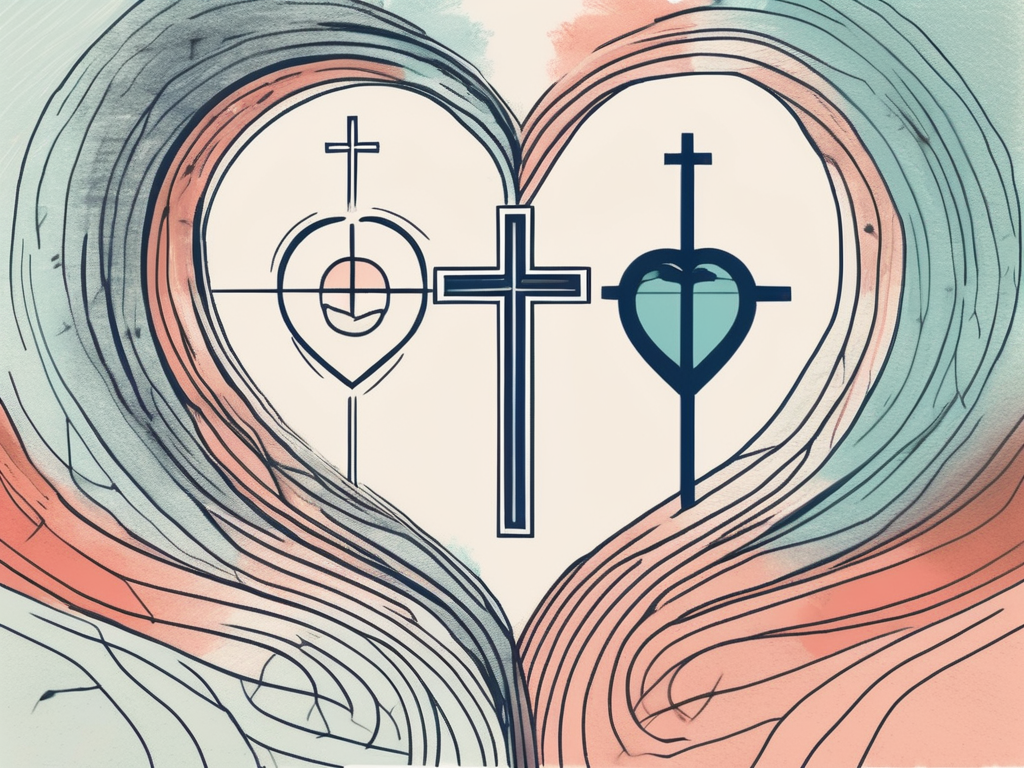Christianity has a rich and captivating history that spans over two thousand years. From its humble beginnings to its widespread influence, this religion has shaped the lives of countless individuals and shaped the course of world events. In this article, we will delve into the intriguing story of Christianity, exploring its birth, growth, and the impact it has had on societies around the globe.
The Birth and Early Years of Christianity
The life and teachings of Jesus Christ form the foundation of Christianity. Born in Bethlehem over two thousand years ago, Jesus emerged as a charismatic figure who preached love, compassion, and forgiveness. His messages resonated with the masses, and he quickly gained a following of devoted disciples.
Jesus’ teachings centered around the concept of salvation and the establishment of the Kingdom of God. His parables and miracles captivated audiences, and he challenged the existing religious and social systems of the time. However, his radical ideas and growing popularity led to opposition from the religious authorities.
As Jesus traveled from village to village, his presence brought hope and healing to those in need. He touched the lives of the sick, the poor, and the marginalized, offering them a glimpse of a better future. His selflessness and compassion were evident in every interaction, as he took the time to listen to people’s stories and offer words of comfort.
The Life and Teachings of Jesus Christ
Jesus’ life was marked by his selflessness and compassion for others. He healed the sick, fed the hungry, and offered hope to the marginalized. His ministry attracted people from all walks of life, from the poor and oppressed to the wealthy and powerful.
Central to his teachings was the commandment to love one another. This idea of unconditional love resonated deeply with his followers and became a defining characteristic of early Christianity.
Jesus’ teachings were not limited to the religious elite; he reached out to the outcasts and the sinners, offering them redemption and a chance at a new life. His message of forgiveness and second chances brought hope to those who had been cast aside by society.
The Role of the Apostles in Spreading Christianity
After Jesus’ crucifixion, his disciples, known as the Apostles, took on the responsibility of spreading his message. They traveled far and wide, sharing the teachings of Jesus with anyone who would listen. Their journeys took them to distant lands, and their unwavering faith helped Christianity to gain a foothold in various regions.
The Apostles faced numerous challenges and opposition during their mission. They endured persecution, imprisonment, and even martyrdom for their beliefs. Yet, their unwavering dedication to spreading the Good News of Jesus Christ laid the foundation for the global expansion of Christianity.
As the Apostles traveled, they encountered people from different cultures and backgrounds. They adapted their message to resonate with each audience, using their knowledge of local customs and traditions to make the teachings of Jesus accessible to all. Their efforts to bridge cultural divides and connect with people on a personal level played a crucial role in the early growth of Christianity.
Persecution of Early Christians in the Roman Empire
Despite its humble beginnings, Christianity quickly gained attention and drew the ire of the Roman Empire. Roman emperors, fearing the growing influence of this new religious movement, enacted various measures to suppress its spread.
Early Christians faced persecution, discrimination, and often became scapegoats for societal problems. Many were martyred for their faith, enduring unimaginable suffering. However, far from extinguishing Christianity, this persecution only fueled its growth and sparked a spirit of martyrdom that transcended boundaries.
As the Roman Empire sought to eradicate Christianity, the faith continued to spread underground. Secret gatherings were held in catacombs and private homes, where believers would gather to worship and share their faith. These clandestine meetings became a symbol of resilience and defiance in the face of persecution.
Despite the risks, early Christians remained steadfast in their beliefs, finding strength in their shared experiences and the teachings of Jesus. Their unwavering faith and willingness to sacrifice their lives for what they believed in inspired others to join their cause, leading to the continued expansion of Christianity even in the face of adversity.
The Establishment of the Church
As Christianity spread, believers faced the challenge of organizing themselves into a cohesive community. This led to the establishment of the Church, which played a crucial role in shaping the future of the faith.
The early Christians, driven by their shared beliefs and a desire for fellowship, gathered together in small groups to worship and study the teachings of Jesus. These gatherings, known as house churches, provided a sense of community and support for the growing number of believers.
As the number of Christians continued to increase, there arose a need for a more formal structure to ensure unity and consistency in their beliefs and practices. This led to the development of a hierarchical system within the Church, with leaders known as bishops overseeing the various congregations.
The Council of Nicaea and the Nicene Creed
In the early fourth century, the Church faced internal divisions and theological disputes. To address these issues, Emperor Constantine summoned the Council of Nicaea in 325 AD. At this council, church leaders gathered to establish a unified doctrine and resolve the controversy surrounding the nature of Jesus Christ.
The council was attended by bishops from all across the Christian world, representing diverse theological perspectives and cultural backgrounds. They engaged in intense debates and discussions, seeking to find common ground and forge a consensus on matters of faith.
After much deliberation, the council reached a momentous decision. They formulated a statement of faith known as the Nicene Creed, which outlined the fundamental beliefs of Christianity. It affirmed Jesus’ divinity and established a doctrinal framework that laid the groundwork for the future of the Church.
The Rise of the Papacy
With the decline of the Roman Empire, the Church emerged as a dominant force in Europe. The Bishop of Rome, known as the Pope, assumed a position of authority and leadership within the Church. This marked the rise of the papacy and its influence over religious and political affairs.
Throughout the Middle Ages, the papacy played a significant role in shaping the course of European history. Popes wielded power, brokered alliances, and championed causes ranging from religious reform to philanthropy. They became not only spiritual leaders but also political figures, exerting their influence over kings and emperors.
The papacy also faced its own challenges and controversies. The Investiture Controversy, for example, was a power struggle between the papacy and secular rulers over the appointment of bishops. This conflict highlighted the tension between religious and political authority in medieval Europe.
The Split Between Eastern and Western Christianity
Over time, theological and cultural differences divided Christianity into two major branches: Eastern Orthodoxy and Western Christianity. The Great Schism of 1054 marked the formal split between the Eastern Orthodox Church and the Roman Catholic Church.
This division resulted from differing interpretations of doctrine, power struggles, and linguistic and cultural barriers. The Eastern Orthodox Church, centered in Constantinople, emphasized the mystical and contemplative aspects of faith, while the Roman Catholic Church, based in Rome, focused on the institutional and sacramental aspects.
Despite the split, both branches of Christianity continued to evolve and develop their own distinct traditions and practices. The Eastern Orthodox Church, for example, embraced the concept of “theosis,” the idea that humans can become united with God through the transformative power of grace. The Roman Catholic Church, on the other hand, emphasized the authority of the Pope and the sacraments as channels of divine grace.
Today, the Eastern Orthodox Church and the Roman Catholic Church remain separate entities, each with its own rich history and unique contributions to the Christian faith.
Christianity During the Middle Ages
The Middle Ages witnessed the rise of Christianity as a dominant force in Europe. During this period, the faith faced various challenges and saw significant developments that shaped its identity.
Christianity in the Middle Ages was not a monolithic entity, but rather a complex tapestry of beliefs, practices, and institutions. It was a time of great religious fervor, intellectual exploration, and social change.
The Crusades and Their Impact on Christianity
The Crusades, a series of military campaigns launched by Western Christians, sought to reclaim the Holy Land from Muslim control. Though driven by a mix of religious fervor and political motivations, the Crusades had a lasting impact on Christianity.
These holy wars intensified religious devotion, spurred cultural exchanges, and reshaped the balance of power in Europe and the Middle East. The Crusaders brought back with them not only relics and treasures but also new ideas, technologies, and knowledge from the Islamic world.
However, the Crusades also led to bloodshed, intolerance, and strained relations between Christian sects and other faiths. The violence and atrocities committed during the Crusades challenged the principles of love, forgiveness, and compassion that lie at the heart of Christianity.
The Role of Monasticism in Medieval Christianity
Monasticism emerged as a defining feature of medieval Christianity. Monasteries, led by monks and nuns, became sanctuaries of devotion, knowledge, and spirituality.
Monastic orders such as the Benedictines, Cistercians, and Franciscans played a pivotal role in preserving knowledge, nurturing spirituality, and providing charitable services to the community. They became centers of learning, art, and social progress, influencing both the Church and the wider society.
Monks and nuns dedicated their lives to prayer, contemplation, and manual labor. They lived in seclusion, following strict rules and engaging in ascetic practices. Through their dedication, monastic communities became beacons of hope and stability in a world often plagued by violence and uncertainty.
Christianity and the Black Death
The devastating Black Death, which swept across Europe in the 14th century, had a profound impact on Christianity. The plague led to widespread suffering, death, and questioning of faith.
During this dark period, many turned to religion for solace and answers. The Church responded with spiritual guidance and rituals to comfort the afflicted. The sacraments of confession, anointing of the sick, and last rites took on heightened importance as people sought forgiveness, healing, and preparation for death.
However, the plague also fueled theological debates and questioning of traditional beliefs, paving the way for the reforms and transformations that would follow. The widespread mortality caused by the Black Death raised profound existential questions about the nature of suffering, the role of God, and the purpose of life.
These debates and inquiries set the stage for the religious and intellectual movements that would shape the Renaissance and the Reformation, challenging the authority of the Church and leading to profound changes in Christian thought and practice.
The Reformation and Its Aftermath
The 16th-century Reformation marked a turning point in the history of Christianity. This period saw the rise of reformers who challenged the authority and practices of the Catholic Church.
Martin Luther and the Protestant Reformation
Martin Luther, a German theologian, became a central figure in the Protestant Reformation. His Ninety-Five Theses, posted on the door of a church in Wittenberg, criticized the corruption and perceived abuses of the Catholic Church.
Luther’s ideas sparked debate and led to a significant schism within Christianity. His emphasis on salvation by faith alone and the authority of scripture challenged the long-standing traditions and practices of the Catholic Church.
The Catholic Counter-Reformation
In response to the Reformation, the Catholic Church initiated its own reform movement, known as the Counter-Reformation. Key figures such as Ignatius of Loyola and Teresa of Avila championed spiritual renewal and worked to address the concerns raised by the reformers.
The Counter-Reformation led to changes within the Church, including improved education for clergy, a renewed focus on spiritual devotion, and a reaffirmation of traditional Catholic doctrines.
The English Reformation and the Church of England
In England, the Reformation took a distinct path under the rule of Henry VIII. The break from the Catholic Church was motivated by political and personal factors, as well as theological disagreements.
Henry VIII established the Church of England, which became the state church and took on a unique blend of Protestant and Catholic elements. The English Reformation had far-reaching consequences, shaping not only religious practices but also the political landscape of England.
Closing Thoughts
From its humble beginnings to its complex and diverse present, the history of Christianity is a testament to the enduring power of faith and the human spirit. Throughout the centuries, this religion has inspired countless individuals, shaped civilizations, and provoked profound theological discussions.
By understanding the fascinating history of Christianity, we gain insight into the forces that have shaped our world. From the life and teachings of Jesus Christ to the struggles and triumphs of believers, the story of Christianity continues to captivate and inspire, leaving an indelible mark on humanity and the course of history.












